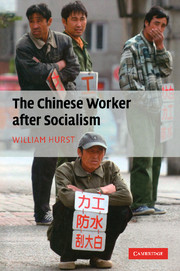Book contents
- Frontmatter
- Contents
- List of illustrations
- Preface
- Introduction
- 1 Regional political economy and labor reform
- 2 The roots of unemployment and the political economy of lay-offs
- 3 Remaking China's urban welfare and labor market policies
- 4 Pathways to re-employment
- 5 Contention, protest, and social order
- Conclusion
- Appendix: List of interviewees
- Bibliography
- Index
3 - Remaking China's urban welfare and labor market policies
Published online by Cambridge University Press: 02 July 2009
- Frontmatter
- Contents
- List of illustrations
- Preface
- Introduction
- 1 Regional political economy and labor reform
- 2 The roots of unemployment and the political economy of lay-offs
- 3 Remaking China's urban welfare and labor market policies
- 4 Pathways to re-employment
- 5 Contention, protest, and social order
- Conclusion
- Appendix: List of interviewees
- Bibliography
- Index
Summary
Introduction
Labor market policy and welfare policy are important aspects of general economic adjustment. This chapter discusses policy initiatives aimed at dealing with urban unemployment in China over time and across regions. The focus is on both implementation and policy effects, intended and unintended, across time and place. Examining welfare reform in the critical case of China also sheds important light on general arguments about social protection.
The basic argument is that as China's old work unit socialist welfare system broke down, the state tried, but largely failed, to replace it. After early moves to revamp the “enterprise-based” model were abandoned, the state later sought to build a new “state-based” system. Successful implementation of the new system, as of 2008, was still dependent on local state capacity, as well as on central–local relations. Extreme regional variation in policy formation and implementation across the whole period from the mid 1990s through 2008 is perhaps the most important characteristic of the process.
The simultaneous pursuit of liberalization and social protection hampered progress toward both objectives. The unraveling of old structures of assistance and control undermined attempts to insulate and compensate losers, while policies that kept the development of a labor market in check impeded other reform goals. Policy responses to lay-offs did not fail in toto, but they were much less effective than intended and informal local initiatives often proved more useful to workers on the ground. Both formal and informal remedies varied substantially by region.
- Type
- Chapter
- Information
- The Chinese Worker after Socialism , pp. 60 - 85Publisher: Cambridge University PressPrint publication year: 2009

